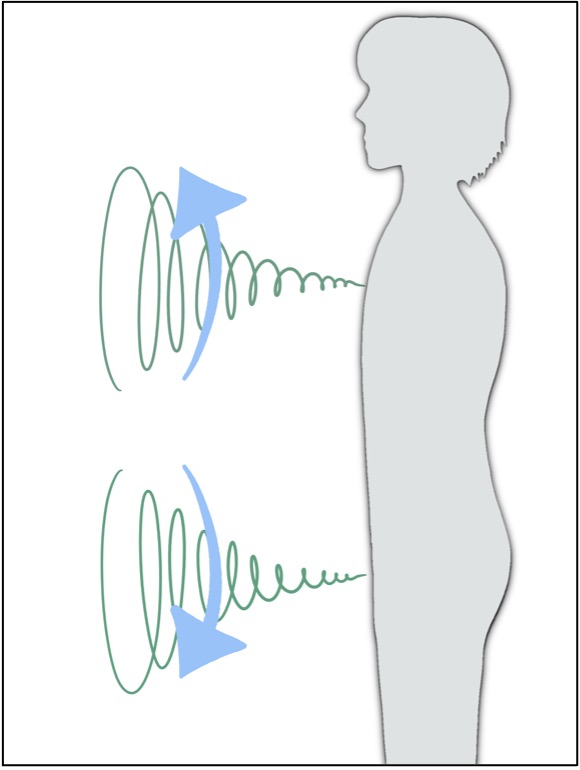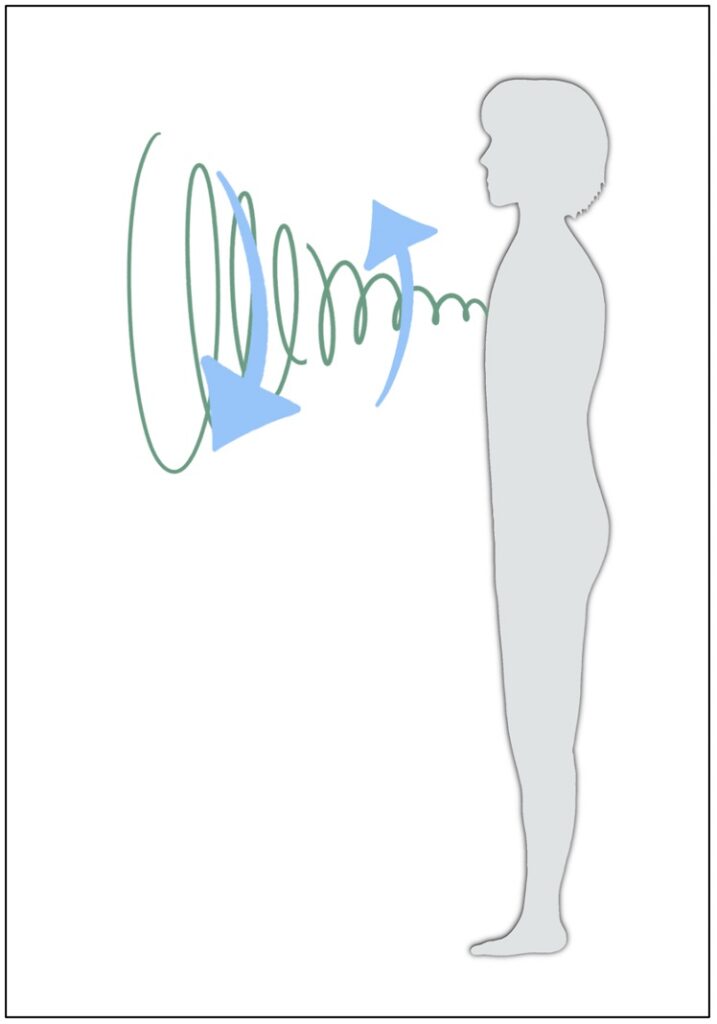Through my years of chakra research, I’ve had several breakthroughs involving how chakras turn, and what I’ve discovered can help clear up some common misconceptions.
Some people believe that one direction is better because it produces positive energy, while the other lowers it. But the truth is a healthy chakra can turn either way—clockwise or counterclockwise—and can change directions as needed. The direction also has nothing to do with whether energy is flowing toward or away from the body. That’s because energy is always flowing through a chakra in both directions. (I’ll explain how this occurs later in this blog.)
The bottom line is it doesn’t matter which way a chakra turns. What matters is how and why they turn.
Chakras Move Energy Toward and Away from the Body at Once
No matter which direction a chakra turns, energy flows through it both toward and away from the body at the same time, like traffic on a two-lane road. (In a healthy chakra, this occurs rhythmically.)
Let’s look at how this dual direction occurs. If you examine how a chakra vortex is constructed, you’ll find that its energetic fabric has two layers, an outer one and an inner one.
The outer layer is structural; it maintains the chakra’s shape. It’s comprised of the nourishing energy it receives from the central chakra channel. Via this outer layer, energy and information flow from the body outward through the aura to give information and feedback to your emotions, memory, and mind.
The inner layer of the chakra fabric is of a higher vibration and consists of life-giving color ray spectrums. As this life energy moves toward the body, it provides the chakra’s structural layer with nourishment. It also picks up information about our true thoughts, memories, and feelings.
Chakras Offer a Source of Vitality
Since the outer layer moves energy/information in one direction and the inner layer moves it in the other—and these movements happen at the same time—there’s going to be friction between them. This friction is essential because it produces electrical-like charges that generate the energy that we experience as vitality.
It is the chakra’s turning motion that vitalizes the body and every layer of the aura through which the chakra passes. A centrifugal motion caused by the turning radiates the electrical charge. The faster the chakra turns, the more of the electrical energy is produced.
This double-layered, energy-producing fabric can be found throughout the chakra system, including within the central chakra channel and the aura itself.

Healthy chakras can turn clockwise or counterclockwise.
Chakras Choose Their Direction
Each chakra is an independent source of intelligence that knows what the body needs, and all seven chakras work together to provide it. To do this, they’ll choose the direction in which they’re going to turn—but the decision is a mechanical one.
We’ve learned one reason chakras turn: to deliver energy. A second reason they turn is to help your aura to rotate.
Maybe you haven’t given it much thought, but ask yourself now: when you think about your aura, do you imagine it moving?
Most people would say no. They don’t think of the aura as something that moves, let alone turns.
In general, we tend to think the aura is static. But in fact, it is not.
A Healthy Aura Rotates
A healthy aura will rotate in whole around the body. It does this for three reasons: to deflect unwanted energy and experiences, to attract and draw in desired energy and experiences, and to support the body’s energy-generating system, of which the chakra system and the aura are just two components.
The chakras act like gears or wheels that keep the aura moving.
When all forward-facing chakras (brow, throat, heart, stomach, sacral, and root chakras) are turning in the same direction, it means the body is exerting the maximum amount of energy that it can in a situation.
It might do this to help you stay alert, respond to an emergency, run a race, or speak in front of an audience.
Then all your gears are moving in the same direction. All are helping your aura to turn.
How Healthy Chakras Help the Aura Rotate
When you sit down to work or rest, some of your chakras may turn in opposite directions to moderate how fast your aura turns. A more slowly moving aura reduces the amount of energy it generates. When it’s time to get up and run errands, more chakras will turn in the same direction.
To help you wind down before bed, the chakras will actually disable themselves, stop turning, and rest. This calms your energy, slows the rotation of your aura, and helps you sleep. Chakras that malfunction by not turning off contribute to insomnia. When your mind is racing, it’s usually your crown chakra that’s actively turning.
By evaluating and comparing the directions of all seven chakras based on certain intentions, you can discover how much energy someone is giving to that area of their life. If all seven chakras are engaged in the same direction, it’s possible the person will become exhausted unless they reconsider their approach.
If just one chakra is turning opposite the others, it means the chakra intelligence centers are moderating the person’s energy, holding a little back just in case more is needed.
Analyzing chakra directions can reveal a great deal about how a person is dealing with certain issues and challenges, including whether they’re caught in indecision.
How Chakras Respond to Indecision

When a person is undecided about something, part of a chakra may move in one direction while another moves the opposite way.
When a chakra turns, it may turn in parts rather than in whole. It is possible that one section of a chakra will move in one direction, and another will move the opposite way.
This phenomenon occurs when a person is trying to make a decision and can’t decide which way to go.
You can tell where the conflict lies by checking where in the aura the opposite turn is occurring. If it’s in the emotional layer, you’re dealing with emotional indecision. If it’s in the causal layer, then something from the past is in the way. If it’s in the mental layer, there’s mental uncertainty involved.
I’ve even seen a chakra move one way and then the other, back and forth all the way through the length of the vortex. This indicates significant confusion on many levels.
For this reason alone, it’s simplistic to say that a chakra will only move in one direction or the other. Chakras are much too dynamic, intelligent, and essential to be limited in this way.
Applied Chakra Analysis
Using Applied Chakra Analysis, you can evaluate each chakra’s direction, length, strength, and shape, and assess the meanings of any anomalies you find. The information you gain will help you understand how chakra anomalies affect your health, or that of your clients or patients.
Learn how to work with your own chakras in my new six-week course, GDI 122: The Applied Chakra Analysis Method.
The Gemstone Therapy Institute Diamond Therapy certified practitioners are qualified to provide clients with comprehensive chakra evaluation and correction. Visit our practitioner directory and contact them if you are interested.

I did not know that chakras or ora rotated at all